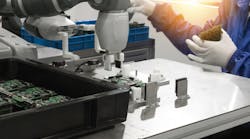In production plants and warehouses, collaborative robots, or cobots, are increasing in number and scope. Unlike traditional industrial robots, cobots are designed to work closely with and safely alongside humans, helping to solve skilled labor shortages and efficiency challenges. New and improved capabilities and deployment options are spurring increased demand.
Technological advancements
Collaborative robots for applications such as assembly, inspection, polishing/deburring, and materials handling are the focus of Doosan Robotics. Its new H-SERIES cobots offer “the highest payload capacity on the market” of up to 25 kg, as well as a reach of 1,700 mm to aid delivery efficiency. In addition, at 72 kg, they weigh half the amount of other cobots in the same class, says Kwangkyu Lee, principle research engineer at Doosan Robotics’s R&D Center.
The new cobot series has strengthened safety controls with collision sensitivity powered by six torque sensors and a gravity compensation algorithm. “With 18 safety functions, the H-SERIES has been validated according to international safety certification requirements and standards,” adds Lee.
The new CRX-10iA collaborative robot family from FANUC America is designed for low volume, high-mix manufacturing. Manual guided teaching simplifies its use. For instance, an operator can manually guide the CRX to desired locations and record points for arc welding applications. In addition to welding, the cobot can perform material handling, palletizing, assembly, dispensing, and other industrial applications.
“FANUC is experiencing a big demand for collaborative robots, primarily because they are easy to use—even for companies with no experience with robots,” says Mark Scherler, a general manager of FANUC America. Cobots can be installed and up and running right out of the box, and when tasks change, cobots are very flexible and can be quickly redeployed, he explains.
The ASSISTA cobot from Mitsubishi Electric Automation is an industrial robot with strength, torque, speed, and precision that by design is also a safe collaborative device for a reasonable price, says Steve Pacitto, product application specialist at Mitsubishi Electric Automation. “This is a significant departure from standard collaborative robots,” he adds.
To increase safety, the ASSISTA goes into a collaborative mode when operators approach it; pinch points are eliminated to protect operator hands and fingers; and internal wiring and piping reduce the challenge of caught or snagged cables. Simple and advanced programming options provide a variety of choices that foster creativity in application development.
Coming in 2021 are two new cobot models from Shibaura Machine, formerly Toshiba Machine, that are engineered for industrial applications. The new humanoid and SCARA models will deliver the performance expected of robotic equipment while incorporating the key safety elements required for collaborative applications, says Ryan Guthrie, technical director at TM Robotics.
For instance, the humanoid model, built to resemble a human, offers up to 16 axes of synchronized movement, including a twist and tilt at the waist. TM Robotics believes this model will outperform previous humanoid models in a number of categories, including payload and strength.
Simplified deployment
Collaborative application simplification is the goal of companies such as OnRobot and Hirebotics. OnRobot is a supplier of robotic tools such as grippers, sensors, and vision cameras, including its new low-cost 2FG7 electric parallel gripper, which can be quickly deployed and redeployed on any major collaborative or light industrial robot.
OnRobot CEO Enrico Krog Iversen believes the era of traditional industrial automation with 12- to 18-month design-to-deployment timelines, large capital outlays, and painfully slow ROI is on the wane. “We think it now makes sense for manufacturers and the industry in general to start thinking in terms of collaborative applications—easy, low-cost automation deployments that use either lightweight industrial robots or cobot arms. OnRobot’s products are designed with this flexible, crossover approach in mind,” he says.
Rob Goldiez, CEO at Hirebotics, suggests that while collaborative robots have reduced the barriers to automation, implementing automation is still really hard for most companies. Hirebotics caters to everyday users with cloud-connected robots for hire.
“For example, BotX is our cobot welder where parts are taught complete from a mobile app that runs on an iPhone or Android device. This approach empowers your skilled welder—but not robot programmer—to take advantage of collaborative robots,” explains Goldiez. The company also recently released its Beacon software for remote monitoring, so that anyone with a Universal Robots (UR) cobot can take advantage of remote monitoring for free.
This article is part of our monthly Technology Toolbox column. Read more from Sheila Kennedy.


